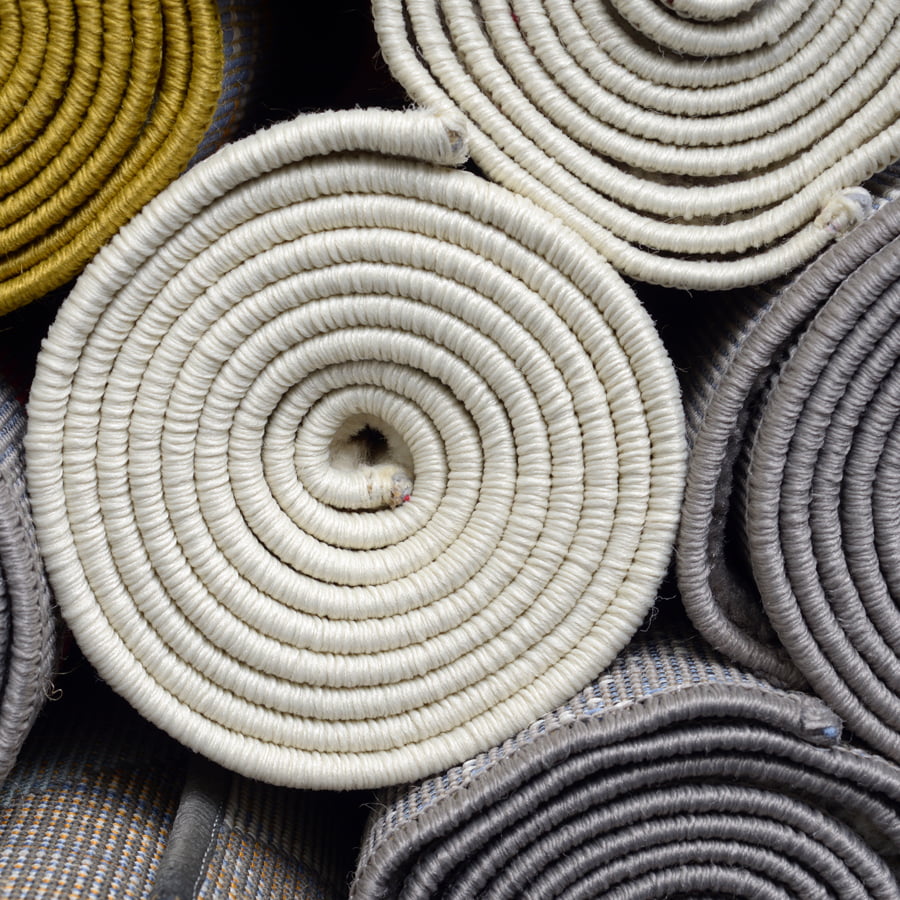A carpet is a textile floor covering consisting of an upper layer of pile attached to a backing. The pile is generally either made from wool or materials such as polypropylene, nylon or polyester, and the backing is typically made from polypropylene, jute or felt. Carpets will help to provide warmth, comfort and noise reduction in homes and other buildings.
One of the biggest questions on people’s minds is whether to choose laminate flooring or carpet for their rooms in the home. So, if you’ve made your decision and that decision is definitely carpet, then this is the post for you.
We’re walking you through the different types of carpets you can buy while helping you create your own criteria for selection. Further down, you can find out more about the differences between pile, material types and backing.
Let’s dive straight in.
Types of Carpets
There are many different types of carpets available, each with its own unique properties. Some of the most common types of carpets include:
- Wool – Wool carpets are the most expensive type of carpet, but they are also the most durable and luxurious. Wool carpets are naturally stain-resistant and fire-retardant, and they can last for decades with proper care.
- Nylon – Nylon carpets are the most popular type of carpet. They are durable, easy to clean and affordable. Nylon carpets are also available in a wide range of colours and styles.
- Polyester – Polyester carpets are a synthetic fibre that is similar to nylon. Polyester carpets are durable, easy to clean and affordable. They are also available in a wide range of colours and styles.
- Polypropylene – Polypropylene carpets are a synthetic fibre that is known for its resistance to stains and moisture. Polypropylene carpets are also easy to clean and affordable.
- Jute carpets: Jute carpets are made from a natural fibre that is grown in India and Bangladesh. Jute carpets are durable and affordable, but they are not as soft or luxurious as wool carpets.
How to Choose a Carpet – your criteria for the best
When choosing a carpet, there are a few factors you should consider, including:
- The type of material: The type of material will determine the durability, softness, and price of the carpet.
- The pile height: The pile height is the measurement of how long the piles are. Carpets with a higher pile height are softer and more luxurious, but they are also more difficult to clean.
- The pattern: Carpets are available in a wide range of patterns, from simple solids to intricate designs. The pattern you choose will depend on your personal style and the décor of your room.
- The colour: Carpets are available in a wide range of colours. The colour you choose will depend on the overall décor of your room and your personal preferences.
- The price: Carpets can range in price from a few hundred dollars to several thousand dollars. The price will depend on the type of Fibre, the pile height, the pattern, the colour, and the size of the carpet.
How to Care for a Carpet
Carpets require regular care to keep them looking their best. Here are a few tips for caring for your carpet:
- Hoover it regularly. This will help to remove dirt, dust and debris that can damage the carpet fibres.
- Spot clean spills immediately. This will help to prevent stains from setting in.
- Avoid using harsh chemicals on your carpet. These chemicals can damage the flooring.
- Have your carpet professionally cleaned every few years. This will help to remove deep-seated dirt and grime.
Why is wool carpet often the most expensive?
Wool carpet is generally more expensive than other types of carpet due to several factors:
- Material Cost: Wool is a natural fibre sourced from sheep, and the production of wool involves shearing, cleaning, and processing the wool. Compared to synthetic materials like nylon or polyester, wool is more expensive to produce and acquire.
- Durability and Quality: Wool is known for its exceptional durability, resilience, and natural elasticity. It can withstand heavy foot traffic and maintain its appearance for a longer time compared to synthetic options. The higher quality and longevity of wool carpets contribute to their higher price.
- Natural Properties: Wool has natural stain-resistant properties due to the presence of lanolin, a waxy substance found in sheep’s wool. This property reduces the need for additional chemical treatments, making wool carpets desirable for those seeking environmentally friendly options. The use of natural materials and reduced reliance on chemicals adds to the cost.
- Manufacturing Process: Wool carpets often require specialised manufacturing processes, including weaving or tufting the wool into the carpet backing. These processes can be more labor-intensive and require skilled craftsmanship, contributing to higher production costs.
- Limited Supply: The availability of wool can also affect its price. The supply of wool is limited compared to synthetic mterials, and it can be influenced by factors such as weather conditions, sheep population, and global demand. Limited supply and fluctuations in raw material prices can lead to higher costs for wool carpets.
It’s important to note that there are various types and grades of wool, and the specific characteristics and quality of the wool used in a carpet can also impact its price. Additionally, factors such as brand reputation, design complexity, and market demand can influence the pricing of wool carpets.
Different carpet backings
Ultimaely, your carpet will have one of 3 different backing types. These are briefly explained below but if you want to find out more about carpet backing specifically, then have a read of our other article Which Carpet Backing is best? And does it really matter?
Jute, polypropylene, and felt are different materials commonly used as carpet backings.
Jute is a natural fibre derived from the jute plant. Polypropylene backing is typically found in less expensive carpets or carpets intended for high-moisture areas such as basements or bathrooms. Felt backing is made from compressed fibres, usually recycled materials.
Would you put a rug on a carpet?
It is common for people to put rugs on top of both carpets and wood floors. The decision to use rugs on top of carpet or wood flooring often depends on personal preferences and the desired aesthetic or functional purposes. Here are some common reasons why people use rugs in both scenarios:
Rugs can add an extra layer of style, colour, and texture to a room, regardless of whether it has carpet or wood flooring. Though they’re not just about style, they can help protect the underlying carpet or wood floor from wear and tear, stains, or scratches. They act as a barrier, especially in high-traffic areas, reducing the direct impact on the floor and extending its lifespan.
Rugs can provide additional comfort and warmth, especially in rooms with hard flooring like wood or tile. They offer a soft and cozy surface to walk on, making the room more comfortable, particularly during colder seasons.
Rugs can help absorb and reduce noise in a room, regardless of the underlying flooring. They can help dampen footsteps, echoes, and overall sound reverberation, creating a quieter and more peaceful environment.
They don’t need to ‘cost-the-earth’ and can be easily moved or changed, allowing for flexibility in room design and layout




